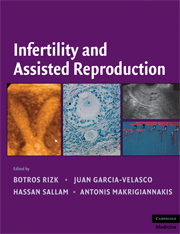Crossref Citations
This Book has been
cited by the following publications. This list is generated based on data provided by Crossref.
Rizk, Botros R. M. B.
Rizk, Christopher R.
Mikhail, Sameh
Rizk, Christine B.
Moustafa, Hany F.
Hole, James
Owens, Sheri
Baker, Susan
and
Porter, Kathy B.
2008.
Infertility and Assisted Reproduction.
p.
371.
Boomsma, C. M.
and
Macklon, N. S.
2008.
Infertility and Assisted Reproduction.
p.
349.
Surrey, Eric S.
2008.
Infertility and Assisted Reproduction.
p.
361.
Badawy, Shawky Z. A.
Shue, Frances
and
Shinners, Jennifer
2008.
Infertility and Assisted Reproduction.
p.
99.
Mikhail, Sameh
Rizk, Botros R. M. B.
Nawar, Mary George
and
Rizk, Christopher B.
2008.
Infertility and Assisted Reproduction.
p.
407.
Konečná, Hana
Kocourková, Jiřina
Burcin, Boris
Kučera, Tomáš
and
Davidová, Karolína
2014.
Can a magic wand plausibly be used in serious psychological research? The complications of researching the ideal age at which to be a parent through the eyes of the child.
Human Affairs,
Vol. 24,
Issue. 3,
p.
354.
Al‐Wattar, Bassel H.
and
Khan, Khalid S.
2021.
Assisted Reproduction Techniques.
p.
706.
Huniadi, Anca
Bimbo-Szuhai, Erika
Botea, Mihai
Zaha, Ioana
Beiusanu, Corina
Pallag, Annamaria
Stefan, Liana
Bodog, Alin
Șandor, Mircea
and
Grierosu, Carmen
2023.
Fertility Predictors in Intrauterine Insemination (IUI).
Journal of Personalized Medicine,
Vol. 13,
Issue. 3,
p.
395.





